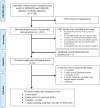Efficacy of extracorporeal plasma therapy for adult native kidney patients with Primary FSGS: a Systematic review
- PMID: 36762994
- PMCID: PMC9930861
- DOI: 10.1080/0886022X.2023.2176694
Efficacy of extracorporeal plasma therapy for adult native kidney patients with Primary FSGS: a Systematic review
Abstract
Purpose: This study aimed to assess efficacy of extracorporeal plasma therapy (EPT), including plasmapheresis (PE), immunoadsorption (IA), low-density lipoprotein apheresis (LDL-A), and lymphocytapheresis (LCAP) for adult native kidney patients with primary focal segmental glomerulosclerosis (FSGS).
Methods: A literature search was conducted using MEDLINE, EMBASE and Cochrane Databases through August 2022. Studies that reported outcomes of EPT in adult native kidneys with primary FSGS were enrolled.
Results: 18 studies with 104 therapy-resistant or refractory primary native FSGS patients were identified. Overall EPT response rate was 56%, with long-term benefit of 46%. Of the 101 non-hemodialysis (HD) patients, 54% achieved remission, with 30% complete remission (CR) and 23% partial remission (PR). Of 31 patients with PE, response rate was 65%; CR and PR rates were 27% and 37% in 30 non-HD patients. Of 61 patients with LDL-A, the response rate was 54%; CR and PR rates were 41% and 3% in 29 non-HD patients. Of 10 patients with IA, response rate was 40%. Of 2 patients with LCAP, 1 achieved CR, and one developed renal failure. All 3 HD patients showed increase in urine output and gradual decrease in urine protein excretion following PE (n = 1) or LDL-A (n = 2). 2 of 3 HD patients ultimately discontinued dialysis.
Conclusion: EPT with immunosuppressive therapy showed benefit in some patients with refractory primary FSGS, and PE appeared to have a higher response rate.
Keywords: Extracorporeal plasma therapy; FSGS; focal segmental glomerulosclerosis; plasmapheresis.
Conflict of interest statement
No potential conflict of interest was reported by the author(s).
Figures
References
-
- Sethi S, Glassock RJ, Fervenza FC.. Focal segmental glomerulosclerosis: towards a better understanding for the practicing nephrologist. Nephrol Dial Transplant. 2015;30(3):375–384. - PubMed
-
- D'Agati V. Pathologic classification of focal segmental glomerulosclerosis. Semin Nephrol. 2003;23(2):117–134. - PubMed
-
- Schwartz MM, Korbet SM.. Primary focal segmental glomerulosclerosis: pathology, histological variants, and pathogenesis. Am J Kidney Dis. 1993;22(6):874–883. - PubMed
Publication types
MeSH terms
LinkOut - more resources
Full Text Sources
Other Literature Sources
Medical
Research Materials

